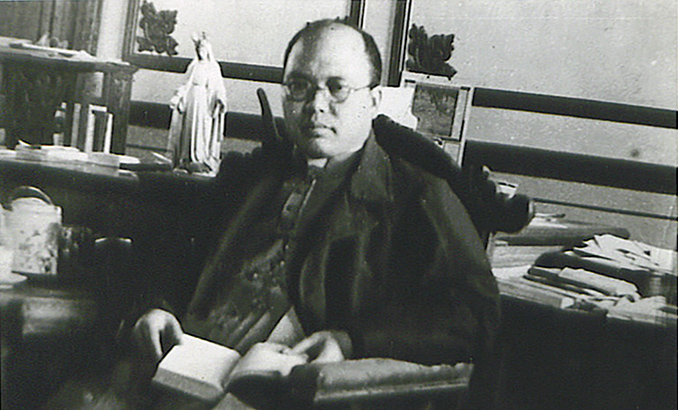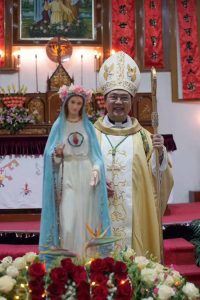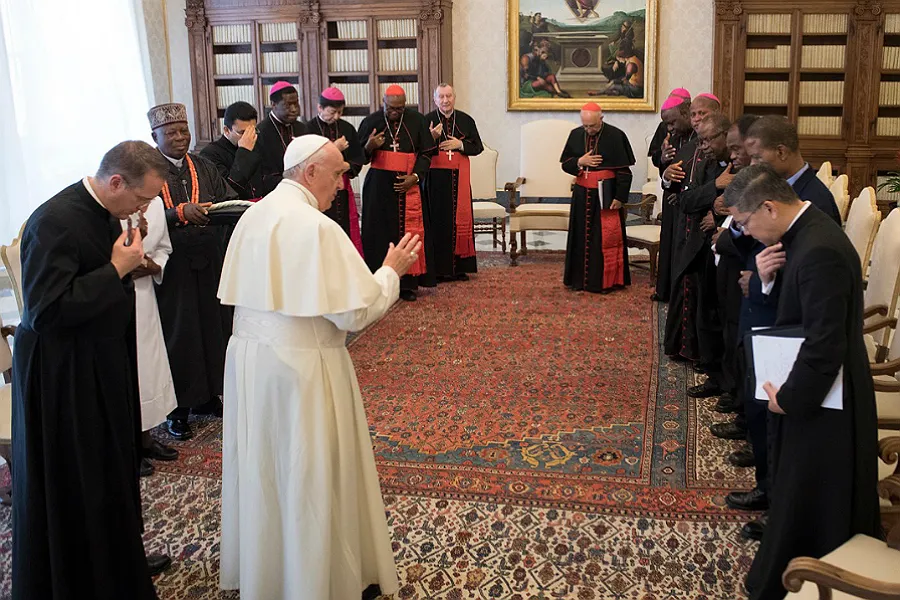
“We cannot command our final perseverance, but must ask it of God.” — St. Thomas Aquinas
“St. Peter is the leader of the choir, the mouth of the apostles and the head of that tribe, the leader of the world, the foundation of the Church, and the ardent lover of Christ.” — St. John Chrysostom
Few issues have plagued China-Vatican relations since the founding of the People’s Republic of China in 1949 more than the question papal authority. China’s political leaders remain uncomfortable with foreign leaders exercising power over Chinese citizens, and Chinese Catholics are among the only people in China who submit to an outside power. In 1951, China’s new communist government committed itself to solving the problem of the “foreign pope” by installing a Chinese one. Party officials approached the Vincentian archbishop, Joseph Zhou Jishi, and invited him to be the pope. Zhou responded that he would be happy to serve as pope, as long as his election was made by the cardinals of the Church in Rome, and that once elected he would live and lead the entire Catholic Church from his papal apartment at the Vatican. For his answer, Archbishop Zhou was arrested in May 1951, subjected to three “people’s trials,” and sent to prison. Since 1949 China’s Catholics have struggled to find ways of remaining loyal to the successor of St. Peter that assuage the government’s requirement to obey the pope in only “spiritual matters,” and not in areas of administration.

This situation has created a painful sense of separation between Chinese Catholics and their spiritual leader in Rome, and an expression of this pain was observed recently during the March 15th general audience with Pope Francis at St. Peter’s. Pope Francis allowed a group Chinese pilgrims to pass through the barrier of Swiss Guards and Vatican carabinieri, approaching him on their knees and sobbing. These Chinese Catholics passed a few tender moments with the successor of the leader of the apostles. No pope has ever visited China, today he remains forbidden from visiting his flock in the Middle Kingdom. While one pilgrim performed the traditional Chinese gesture of obedience, the kowtow, another asked him to bless their statue of Our Lady of Fatima. There are two realities that define China’s Catholics: Today they are sustained by their abiding devotion to Jesus Christ, and they are plagued by their abiding struggle to navigate between a political requirement to remain distanced from the pope of Rome and a spiritual requirement to submit to his authority. Recent events in China highlight the complexities of this situation.
After an extended period of living under house arrest for refusing affiliation with the state-sponsored Chinese Catholic Patriotic Association, Bishop Thaddeus Ma Daqin emerged from his confinement to concelebrate Mass on April 17, 2017 with Bishop Vincent Zhan Silu, who is not in communion with the Holy Father. Some local Catholics have decried Ma’s concelebration as “blasphemous”. This was Bishop Ma’s first public Mass since 2012, and many of China’s faithful feel betrayed by his unexpected rapprochement with an illicit bishop. “Shen cang bu lu 深藏不露,” exclaim some, which means, “A hidden intention hides below.” In the same month, a police raid of an “underground” Catholic church in Heilongjiang province left Catholics fearful that the Church’s apparent freedoms gained since the 2008 Olympics are slowly being eroded by renewed state attempts to control and diminish the flock under St. Peter’s successor. I wrote in August 2016 of rumors that Bishop Ma had released an “admission of his faults,” and that he had reneged his former repudiation of the Catholic Patriotic Association. For many Chinese Catholics, his concelebration with an illicit bishop represents lost hope that China’s bishops can effectively resist state control, while for many others his concelebration signifies Ma’s practical commitment to preserving the faith in China under the Church’s present circumstances.
Despite the news of Bishop Ma Daqin’s concelebration and the ongoing, and unresolved, saga of reported negotiations between the Vatican and China’s government regarding the current system of selecting bishops, China’s Catholics continue to flourish. According to a recent report published by UCANews, “There were 4,446 new Catholics baptized in China’s northern Hebei province during Easter, the highest amount in the country during the same time.” Central Shanxi province reported 1,593 baptisms during Easter Vigil, and there were 1,327 at southern Guangdong, 1,234 from northwestern Shaanxi, 1,169 from eastern Shandong, 1,168 from eastern Zhejiang, and 1,097 from central Henan. Baptismal statistics for China are impossible to accurately discern since two-thirds of the country’s Catholics are members of the “underground” community, and cannot openly report their records. That said, a preliminary report from the sanctioned Church accounts for 19,087 new Catholics in China this Easter. Other hopeful signs can be found in China’s large cities. In Beijing, for example, the city’s largest church, Beitang (北堂 “North Church”), is being restored largely at the government’s expense, and the former bishop’s residence attached to the Beitang complex is being returned to the Catholic community. Once the stunning Gothic-style church is completely restored it shall again serve as Beijing’s grand cathedral. The state is funding a major repair and restoration of Shanghai’s St. Ignatius cathedral, first designed by the famous English architect, William Doyle, in 1906. The restoration of these two Catholic churches is costing the government around ten million US dollars, and they will serve the rapidly growing number of China’s Catholics.

Meanwhile, in April, police officials raided a small gathering of unsanctioned Catholics during Mass, heralding what they viewed as successfully “blocking an illegal religious gathering.” Officials ransacked the room and attempted to arrest the huizhang (會長 “community elder”) and priest, all of which briefly appeared in an online video. A still image from that video was posted on the Chinese webpage of UCANews on April 27th. Events such as this remind the faithful that the situation for Catholics remains complicated, and that “perseverance under Peter” can come with costs. This incident followed the arrests of two “underground” bishops, Bishop Peter Shao Zhumin, of Wenzhou, and Bishop Vincent Guo Xijin, of Mindong, and rumors suggest that these two prelates were seized to prevent them from celebrating Easter Masses. The state continues to iterate its position that religious activities are allowed as long as they are conducted under the auspices of the Religious Affairs Bureau and the Chinese Catholic Patriotic Association. Navigating within these parameters is often rewarded with generous state support, as is now seen in the construction and restoration of Catholic churches throughout China. The central anxiety among those sitting in China’s pews, however, revolves around the question of papal authority within a national system that insists upon total independence from foreign interference. But the technical area of ecclesial authority is not the only issue that occupies the thoughts of China’s Catholics.
The Chinese Jesuit Fr. Joseph Jiang recently published a commentary on the state of Chinese Catholicism in La Civiltà Cattolica, entitled “Catholicism in 21st Century China”, wherein he notes China’s modern malaise due to the empty rewards of materialism. He asks: “Is the Chinese Catholic Church ready to face this challenge?” Given China’s persistent shortage of clergy, Jiang suggests that the Church in China must “empower the laity to take more leadership roles in the Church’s mission,” so that a more robust spiritual life among the faithful can mitigate the temptations of hyper-materialism. He also recommends that the Church in China more effectively utilize internet networking “to keep up with the times.” What is perhaps most intriguing about Jiang’s essay, however, is his assertion that:
Because China is so different from the rest of the world, the Chinese Catholic Church needs to learn how to deal with the local culture and political authority. In other words, while keeping its Catholic identity, the Church has to establish a ‘Chinese Catholic Church with Chinese Characteristics,’ if it is to enculturate Church teachings and gospel values that are relevant to the Chinese people and serve both their [own] and Catholics’ spiritual needs.
In order to “remain relevant to the needs of the new generation,” Fr. Jiang suggests that the Church must adopt itself to the particular realities of modern Chinese society, and he borrows from the rhetoric of China’s communist party, which states that China must have “socialism with Chinese characteristics (Zhongguo tese shehuizhuyi中國特色社會主義),” an idea encouraged by party leaders such as Deng Xiaoping, Hu Yaobang, and Zhao Ziyang. Just as Marxist economic theories cannot conform precisely to the ideals of Karl Marx, neither can the Church’s conventional model conform precisely to the culture of the Chinese Church. He suggests, though, that China’s Church must keep “its catholic identity.” To facilitate this accommodation, Jiang asserts that, “the Chinese Catholic Church will have to redefine its role and relationship with the Party and its ideological theories. This does not necessarily mean that the Church has to agree completely with Party politics and values, but it must find flexible and effective way[s] to continue its mission and ministry in China.”
Fr. Jiang’s assessment and proposal is largely pastoral, and on that level it has several merits. But Jiang’s suggestion overlooks that present realities in China are quite distinct from China’s past. Before 1949, when China’s political authorities became entirely communist, emperors and presidents had been religious persons, and the question of belief and religious practice was more a matter of “orthodoxy” than a matter of whether or not religion is altogether socially harmful. China’s current polity at best tolerates religious practice; at worst, it actively seeks to abolish it. China’s emperors were either Daoist or Buddhist, and the president of the Republican Era, Chiang Kai-shek, was a baptized Christian. Another aspect that complicates Sino-Vatican accord today is the question of the selection of bishops, which China’s government still refuses to return to the pope. China’s emperors, as tyrannical as they often were, never infringed upon the pope’s authority to select priests for consecration to the episcopacy. When party officials asked Bishop Joseph Zhou Jishi to be the pope of China, an entirely new form of “Chinese Catholic Church with Chinese Characteristics” was proposed by China’s new government. The issue of St. Peter’s role in the Church remains central, and how this bedrock reality of Catholic identity is handled in China will dictate the course of Catholicism in China as it continues its historical path. Fr. Jiang calls for the Sinicization (“Chinese-ification”) of China’s Church, and I unequivocally agree with that part of his summons; but the Church in China already began this process in the early-twentieth century. It is in fact more Sinicized now than ever before. To place too much emphasis on the cultural dialogue between contemporary China and Catholicism is overly optimistic. Cultural rapprochement shall be an essential component for improving the spiritual and material lives of China’s Catholics, but many – perhaps most – of China’s Catholics would like to see the issue of Peter finally resolved so that the leader of the apostles can finally visit his flock in China and function as the genuine pastor of China’s Catholics.
I may be accused of stubbornly adhering to a long and persistent antagonism between the Vatican and China’s post-1949 authorities, but I would note that genuine and lasting reconciliation must begin with honesty. Pope Emeritus Benedict XVI, in the opening line of his encyclical Caritas in Verite, wrote that, “Charity in truth, to which Jesus Christ bore witness by his earthly life and especially by his death and resurrection, is the principal driving force behind the authentic development of every person and of all humanity.” Fr. Jiang’s essay, which I largely agree with, suggests that, “As China and Chinese society in general become more and more open to religions – and to [the] Catholic Church in particular – Catholicism can find a stable place if it continues to be a Church of openness and a Church with Chinese characteristics and identity.” As a historian of China, I am convinced that China has never been, at least officially, less and less open to religions than it is today. All of my courses begin with a several-week section on Chinese philosophy and religion, and from the Shang dynasty (1600-1045 BC) until the Republican Era (1911-1949), China was far more spiritually minded than it is now.

The fact that China’s Church is indeed growing, and that churches are overflowing with faithful at each Mass is a hopeful reality, and the challenges faced by China’s government actually lie beyond the scope of religious practice. Creating opportunities for 1.4 billion people to support themselves and maintain an agreeable standard of life occupies much of the discussions held each time the party meets in Beijing. Yet for Catholics, as long as prayer and Eucharistic gatherings are designated as “sanctioned” and “unsanctioned,” and as long as the pope is viewed as a “foreign threat” to the people of China, there are larger issues to discuss than Sinicization. Although historical factors will undoubtedly require time and patience as China’s Catholics unhurriedly seek to normalize – yes, with “Chinese characteristics” – their relationship to Rome remains central. As long as bishops, priests, and faithful feel pressed between their loyalty to Rome and their patriotism for their country, incidents such as the illicit concelebration between Bishops Ma and Zhan, and the indiscriminate raiding of private gatherings for Mass shall continue to afflict China’s Catholic community.
All this being said, Pope Francis has made it clear that China’s faithful remain close to his heart. In his May 21, 2017 Regina Caeli prayer, the Holy Father said:
Next May 24 we will all be united spiritually to the Catholic faithful of China, on the feast of the Blessed Virgin Mary “Help of Christians,” venerated at the Sheshan Shrine at Shanghai. To Chinese Catholics I say: Let us raise our gaze to Mary Our Mother, so that she may help us to discern the Will of God regarding the concrete path of the Church in China and support us in accepting her plan of love with generosity. Mary encourages us to offer our personal contribution towards communion among believers and for the harmony of the society as a whole. Let us not forget to bear witness to faith with prayer and with love, always remaining open to encounter and dialogue.
Pope Francis has generously opened the path for dialogue with China’s authorities, while also appealing to Our Lady of Sheshan to help “discern the Will of God regarding the concrete path of the Church in China.”
I’ll conclude with an announcement of an event few American Catholics are aware of, a biannual gathering of Chinese and American Catholics sponsored by the U.S. Catholic China Bureau. This year’s national conference will be in New York, from 11-13 August, 2017, at St. John’s University, and the theme of the gathering will be understanding the Chinese Church of the twenty-first century. I mention this gathering because when I ask Chinese Catholics what they wish most of American Catholics, they quickly reply: “I wish to have a chance for them to get to know us, to know that we are also part of the Church.” One of the two keynote speakers is a Chinese priest, Father Joseph Zhang, a biblical scholar from China, who will deliver a talk entitled, “Contemporary Chinese Catholicism: Present and Future Realities.” Events such as this are a remarkable opportunity for Americans to encounter the inspiring spirituality of Chinese Catholics, whose dedication to the successor of St. Peter, and the faith of the apostles, is a moving testament to the work of the Holy Spirit in the Universal Church.
If you value the news and views Catholic World Report provides, please consider donating to support our efforts. Your contribution will help us continue to make CWR available to all readers worldwide for free, without a subscription. Thank you for your generosity!
Click here for more information on donating to CWR. Click here to sign up for our newsletter.






And yet, I would expect, that none of this is mentioned in the present PBS presentation about China (which I have not seen), and which I understand forgets to even mention Confucius.
Thank you so much for this informative piece on the Catholic Church in China. It’s really edifying, as it encourages an open heart and mind to our Chinese Catholic brethren. Together in prayer, we can work towards a spiritual liberation for Chinese Catholics and a greater depth of compassion for their hardships, trying to live out their call to Christian obedience while living in a communist country. God bless them!
-Jessica, From San Francisco Bay Area
Insightful and thoughtful, as always, Dr. Clark.
I was looking for best Catholic information and suddenly I click on this post almost I have just spent my 15 minutes on it and get more and more information because i am student of MBBS in China but a international student.